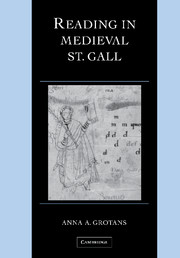Book contents
- Frontmatter
- Dedication
- Contents
- List of plates
- Acknowledgments
- List of abbreviations
- Manuscript punctuation and other symbols
- Introduction
- 1 Medieval reading
- 2 Education at ST. Gall
- 3 Language use and choice
- 4 The ST. Gall Tractate
- 5 Discretio in the classroom
- 6 Accentus
- 7 Spelling for reading
- Bibliography
- Index of manuscripts
- General index
2 - Education at ST. Gall
Published online by Cambridge University Press: 13 May 2010
- Frontmatter
- Dedication
- Contents
- List of plates
- Acknowledgments
- List of abbreviations
- Manuscript punctuation and other symbols
- Introduction
- 1 Medieval reading
- 2 Education at ST. Gall
- 3 Language use and choice
- 4 The ST. Gall Tractate
- 5 Discretio in the classroom
- 6 Accentus
- 7 Spelling for reading
- Bibliography
- Index of manuscripts
- General index
Summary
Álso ih in scÛolo gelírneta,
sô gehúgo íh is nóh.
In a letter to the monks of Reichenau, the renowned Latin grammarian Gunzo of Novara relates a personally embarrassing yet telling incident concerning the status and level of Latin instruction at nearby St. Gall, where he had a chance to visit on his way from Italy to Flanders in the year 960. During conversation after the evening meal, it appears that Gunzo had in one instance used an accusative instead of an ablative case ending. His St. Gall hosts did not let the apparent grammatical slip pass lightly and without comment. One young monk, probably in the name of fairness, suggested that such a crime against Latin grammar deserved the rod, and another composed a verse on the spot to mark the occasion!
It is not surprising that the St. Gall monks prided themselves on the correctness of their Latinity. The school at St. Gall was an acclaimed centre of learning from the ninth to the eleventh centuries. In the late tenth century, Balther of Säckingen, who went on to become head of the cathedral school in Speyer and in 970 bishop there, describes his alma mater as a fountain of learning, whence knowledge sprang forth to flow throughout Europe. Some of the school's most illustrious masters were Ratpert († ca. 884), Iso († 871), Marcellus († 869), Tuotilo († ca. 912), Notker Balbulus († ca.
- Type
- Chapter
- Information
- Reading in Medieval St. Gall , pp. 49 - 110Publisher: Cambridge University PressPrint publication year: 2006
- 1
- Cited by

